

Trader Joe's Ex-President Opens Store With Aging Food And Cheap Meals. Trader Joe's Ex-President Opens Store With Aging Food And Cheap Meals. Think Nobody Wants To Buy Ugly Fruits And Veggies? Think Again. Remember that old movie trope, in which the mousy girl who never gets noticed takes off her eyeglasses and — voila!

— suddenly, everyone can see she was beautiful all along? She was a beauty the whole time?! Marilyn Monroe in How To Marry A Millionaire. The Kobal Collection hide caption itoggle caption The Kobal Collection She was a beauty the whole time?! The Kobal Collection Well, a similar sort of scenario is starting to play out in the world of produce in the U.S. France to force big supermarkets to give unsold food to charities.
French supermarkets will be banned from throwing away or destroying unsold food and must instead donate it to charities or for animal feed, under a law set to crack down on food waste.
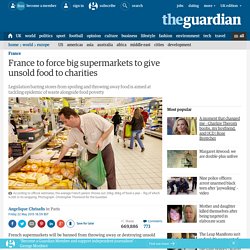
The French national assembly voted unanimously to pass the legislation as France battles an epidemic of wasted food that has highlighted the divide between giant food firms and people who are struggling to eat. As MPs united in a rare cross-party consensus, the centre-right deputy Yves Jégo told parliament: “There’s an absolute urgency – charities are desperate for food. The most moving part of this law is that it opens us up to others who are suffering.” This new startup wants to sell you ugly fruit and veggies. Originally published on Grist.
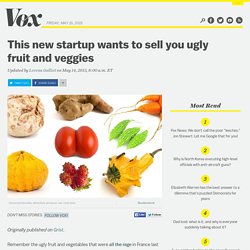
Remember the ugly fruit and vegetables that were all the rage in France last summer? We’ll, they’re coming to America. More to the point: They’ve actually been here this whole time — just not on most people’s plates, nor in supermarket aisles. Food Recovery Network mini documentary. Chefs Daniel Patterson and Roy Choi Reimagine Fast Food.
IN COPENHAGEN in the summer of 2013, Daniel Patterson, a two-Michelin-star chef with four restaurants in California’s Bay Area, watched as the Los Angeles–based chef Roy Choi gave a speech about the millions of Californians who are hungry or live in fear of going hungry.

As Patterson sat in the audience at the MAD Symposium in the Danish capital, an annual event that gathers thought leaders in the field of food, he was reminded of his own social-justice initiative, called the Cooking Project, which works with kids and adults in San Francisco’s toughest neighborhood, the Tenderloin. “The idea,” he says, “is that by teaching some basic cooking skills, we can greatly improve eating in areas where nutritious and delicious meals are hard to come by.” Patterson wanted to expand his idea in the form of a fast-food restaurant. It would link the Cooking Project to social enterprise, creating jobs in the Tenderloin. The Loco’l burger is two-thirds meat and one-third whole grain. “A million?” The picking, donating or distributing of fruit for humanitarian purposes. For Businesses - Feedback. Food For Good.
FREQUENTLY ASKED QUESTIONS. Q1:Does Food Not Bombs get its food from dumpsters?
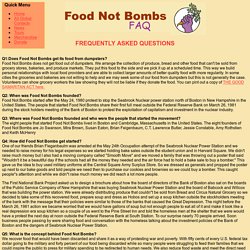
Fighting Waste, Feeding People. Food waste feeds the future - Agriculture - Livestock. AS THE price of feed grain remains high about $10 a tonne to $15/t above this time last year, and seasons across the country continue to be dry, producers are looking for alternatives when it comes to stock feed.
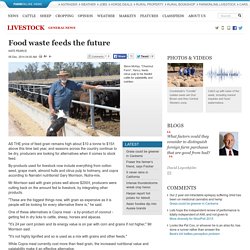
By-products used for livestock now include everything from cotton seed, grape mark, almond hulls and citrus pulp to holmany, and copra according to Narrabri nutritionist Gary Morrison, Nutra-mix. Mr Morrison said with grain prices well above $200/t, producers were cutting back on the amount fed to livestock, by integrating other products. "These are the biggest things now, with grain as expensive as it is people will be looking for every alternative there is," he said. Bread waste into enzymes: Study. A study published in the Journal of Food and Bioproducts Processing found that through solid state fermentation, it is possible to develop a multi-enzyme solution rich in glucoamylase and protease from waste bread.
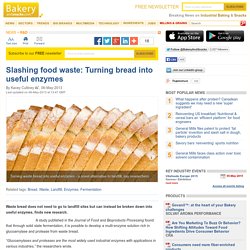
“Glucoamylases and proteases are the most widely used industrial enzymes with applications in various industries,” the researchers wrote. Food waste u-turn by Labour. “Labour’s backtrack on banning food waste to landfill is hugely disappointing news for the entire waste management sector,” said Philip Simpson, commercial director at ReFood.

“In the next five years, landfill sites across the UK will be nearing capacity, which makes minimising the volume of unnecessary waste and increasing recycling figures absolutely essential.” Election manifesto. Scientists turn Starbucks food waste into bioplastic. The biorefinery changed food waste such as spent coffee grounds and stale bakery goods from the retail chain in Hong Kong into succinic acid for making plastics.

A Simple Acid Soak Turns Food Waste Into Plastics. Researchers report a simple method to convert food waste into cellulose-based plastics of varying thermal and mechanical properties (Macromolecules 2014, DOI: 10.1021/ma5008557).
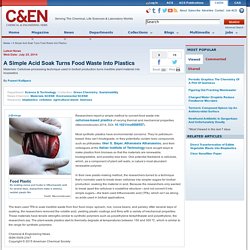
Most synthetic plastics have environmental concerns: They’re petroleum-based; they can’t biodegrade; or they potentially contain toxic compounds such as phthalates. Ilker S. Bayer, Athanassia Athanassiou, and their colleagues at the Italian Institute of Technology have sought ways to make plastics from biomass so that the materials are renewable, biodegradable, and possibly less toxic. Whole Foods Market tests novel food waste technology developed by ex-Microsoft execs. The beauty of WISErg’s Harvester devices - which can convert up to 4,000lb/day of food waste (from coffee grounds and meat/bone scraps to produce) into liquid that is later further refined and turned into a nutrient-rich fertilizer - is that they enable retailers to track exactly what they are throwing away, when, and use this knowledge to become more efficient, co-founder Larry LeSueur told FoodNavigator-USA.
While retailers already measure shrinkage in the sense that they know the difference between what is delivered to a store and what goes through the checkout, more granular data revealing exactly what is being dumped and when, can help pinpoint where and why waste is being generated, enabling stores to improve inventory management, address staff training issues, or change the way they work, he said. We wanted to create something that is sustainable and economically viable No smelly odors. OSU turns winemaking waste into food supplements and flowerpots. CORVALLIS, Ore. – Researchers at Oregon State University have discovered how to turn the pulp from crushed wine grapes into a natural food preservative, biodegradable packaging materials and a nutritional enhancement for baked goods. The United States wine industry creates a tremendous amount of waste from processing more than 4 million tons of grapes each year, mostly in the Pacific Northwest and California, according to the U.S.
Department of Agriculture. Wineries typically pay for the pulp to be hauled away, but a small percentage is used in low-value products such as fertilizer and cow feed. "We now know pomace can be a sustainable source of material for a wide range of goods," said researcher Yanyun Zhao, a professor and value-added food products specialist with the OSU Extension Service. Bring the Food. The Bristol Skipchen: a Real Junk Food Project. The Real Junk Food Project.